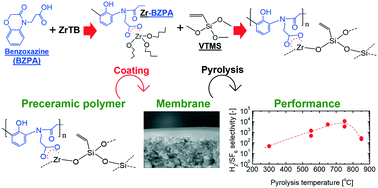Design of carbon–ceramic composite membranes with tunable molecular cut-offs from a carboxylic benzoxazine ligand chelated to silica–zirconia†
Abstract
Carbon molecular sieve and composite carbon molecular sieving membranes are fabricated via the traditional methods of pyrolyzing polymers or by using preceramic composite polymers bearing macromolecular structures. Scant attention is paid to the design of the precursor structures in the tailoring of these membranes. In this study, a preceramic resin sol was formed using separate precursors that included vinyltrimethoxysilane (VTMS), zirconium n-butoxide (ZrTB), and a carboxylic benzoxazine ligand–3-(3-oxo-1,4-benzoxazin-4-yl)propanoic acid (BZPA), which was analyzed via FTIR. Additional XPS analysis revealed the formation of sp2 hybridized carbon structures after pyrolysis of the preceramic resin between 550 and 850 °C. A composite VTMS–ZrTB–BZPA resin sol was used to fabricate thin carbon–ceramic membranes with molecular sieving performances that could be tuned via the pyrolysis temperature, and H2/SF6 and H2/CH4 selectivities of 104 and 102, respectively, were achieved. This work offers a flexible method for the fabrication of high-performance carbon–ceramic composite membranes by focusing on the ground-up design of precursor preceramic polymer structures in addition to processing parameters.

- This article is part of the themed collections: MSDE Recent HOT Articles and Emerging Investigator Series


 Please wait while we load your content...
Please wait while we load your content...